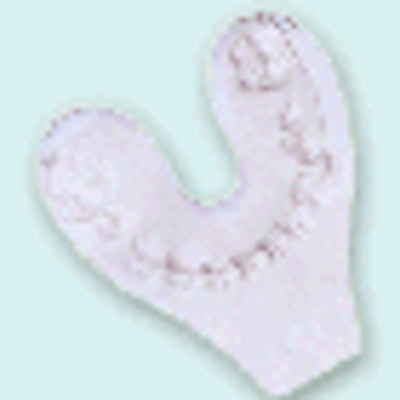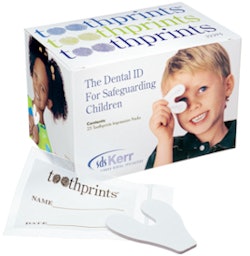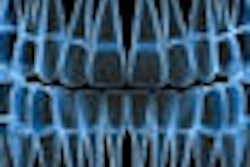
John Haze, D.M.D., an orthodontist in New Jersey, offers his young patients something more than perfectly aligned pearly whites -- he throws in free dental IDs known as Toothprints.
Developed by Dave Tesini, D.M.D., a pediatric dentist from Massachusetts, Toothprints are dental impressions that serve as a unique form of personal identification that can help law enforcement officials should a child go missing, get lost, or be abducted, Dr. Haze said.
Each Toothprint begins with an arch-shaped thermoplastic dental impression wafer that is softened in hot water. The patient bites down on it for 20 seconds, and the patient's individual tooth characteristics, tooth position within the arch, and the upper to lower jaw relationship are all recorded in the plastic wafer. The wafer with the tooth imprint is placed in a plastic bag with the patient's name on it and can be stored at home. Toothprints also capture saliva, another form of ID.
 |
| Image courtesy of Kerr Dental. |
The first print can be taken at age 3 when all the primary teeth have erupted, and prints can be updated every few years.
"Law enforcement officials rarely have ID materials available for teenagers, yet teens are the most likely to become lost, missing, or abducted," said David Harte, D.M.D., director of the Massachusetts Masonic Child Identification Program, in a Kerr press release. "Toothprints offers a very powerful recovery and identification component of any child's identification kit."
Dr. Haze got the idea for Toothprints from a conversation with his 10-year-old granddaughter. They were watching TV when she asked him, "Is there a DNA test for children?"
Now he offers free Toothprints to his young patients, and the families really appreciate it, he said.
"It's something good I want to do because of concern for my patients," Dr. Haze said. Although the procedure costs only about $3.00 per patient, it has great PR impact, he added.
However, not everyone is convinced that Toothprints is a powerful or accurate identification tool.
Peter Hampl, president of the American Board of Forensic Odontology, directed all questions about Toothprints to the organizations' position paper.
The organization does not discourage the use of thermoplastic material to record the anatomy and morphology of the dentition, but considers it of little use in forensic dental identification.
Because the technique is mostly aimed at children, it is of limited use because of the ongoing growth and development of a child's mouth, the organization explains in the position paper. Also, decomposed remains of children can present special dental identification challenges, such as single-rooted primary teeth, teeth with resorbing roots, and developing permanent teeth that are often missing, leaving few teeth for making comparisons. In such cases, dental radiographs are a much more efficient form of identification.
"This method should not be considered a substitute for obtaining and keeping accurate, conventional dental records," the paper states.
A 2007 study that looked at bite registrations for subjects age 7-12 using Toothprints found that it captured DNA but not in high quantities, and did not produce an accurate representation of the dentition (Journal of the American Dental Association, September 2007, Vol. 138:9, pp. 1234-1240).
"The dental impression wafers captured enough DNA to permit amplification," the authors concluded. "The accuracy of the bite registration was not sufficient for identification purposes. Therefore, dental impression wafers may be useful only as a reservoir for DNA."



















